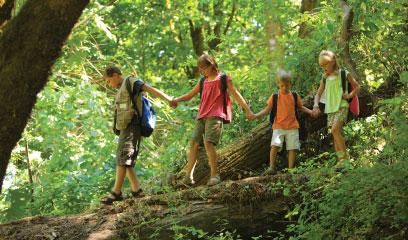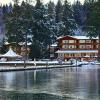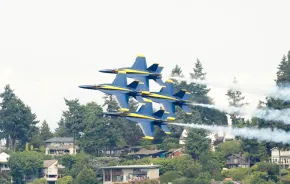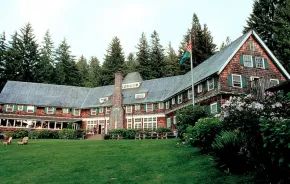 If you’re a Northwest parent, you may have spent several uneasy years fending off the suggestion that you should be taking your kids camping. After all, easy access to spectacular camp sites is one of the best reasons to live in our area, right? But, unless you were raised by camping parents yourself, the challenges of gearing up, getting out and setting up can seem as insurmountable as that Mount Si hike you’ve been meaning to get to. Life is busy. Why pick a sport that requires so much output on the front end?
If you’re a Northwest parent, you may have spent several uneasy years fending off the suggestion that you should be taking your kids camping. After all, easy access to spectacular camp sites is one of the best reasons to live in our area, right? But, unless you were raised by camping parents yourself, the challenges of gearing up, getting out and setting up can seem as insurmountable as that Mount Si hike you’ve been meaning to get to. Life is busy. Why pick a sport that requires so much output on the front end?
Lots of reasons. Kids who go camping gain much more than an appreciation for s’mores and the nuances of bug spray. The camping experience puts kids in touch with a deep, elemental affection for nature — something too few kids today ever get. Kids belong in the dirt and the trees, and those unforgettable fireside memories will last a lifetime. Plus, camping is fun — big fun! — if you’re organized and relaxed enough to let go and enjoy it. So here’s a camping veteran’s take on how to ease your wild things into a family camping adventure. Call it “glamping” — glamour camping — an approach to “roughing it” that makes comfort a priority.
Step 1: Start early
Believe it or not, the best sites get booked up before summer even starts! It's already getting late to make your reservations. Start by asking yourself what’s important: Do you require flushing toilets and showers? (Really? Even for just a one-nighter?) Should your site be on a river — or safely away from moving water? Do you need space from other campers to be happy, or does co-habbing add to the fun?
Also, consider how far you’re willing to drive and whether you require eastern Washington odds on sunny weather. Then go online (see below) and choose your campground and site, based on the campground map. Don’t pick the site next to the bathroom — you’ll hear talking and doors slamming all night. Sites are inexpensive (usually around $20-$30 a night). Nail down a plan now, then start to gather your glamping gear.
Step 2: Gear up
Yes, camping does require lots of gear, but maybe not as much as you think. If you’re lucky enough to know a camping family, ask them if you can borrow a few things for your maiden voyage. You’ll need a tent, and don’t scrimp on size. We’re talking about car camping here; no extra credit for traveling light. The first rule of glamping is to know when to compromise; tent size is not the place. My family has enjoyed many nights in our ridiculous “Taj Mahal” — a monstrous Kelty tent purchased at Costco 10 years ago. It’s big enough to stand up in, and its size allows us to weather rainy days at camp in comfort.
Practice putting up your tent in the backyard at least once before the big day. Trust me on this.
You’ll also need warm sleeping bags (not “sleepover” bags) and foam pads or air mattresses of some kind. These can also be borrowed, especially the mattresses. Remember: A comfortable night’s sleep is key to good glamping. There is no way to cook risotto with Asiago if you’re staggering around camp in a daze.
For containing food, you’ll need a good, large ice chest and a few big plastic bins with lids. These you’ll keep in your car, to keep critter visits to a minimum. You’ll also need a little propane stove and a few pots and pans. Keep it simple for this first outing; do what works, what’s easy and delicious. Toss in a few yogurts and a bakery box of muffins for breakfast; bagels and cream cheese make a practically crush-proof lunch (great for hiking). For dinner, pasta, a jar of sauce and some good rolls make a hearty meal, as does a hot dog, roasted on a stick. Serve it all up on paper plates (just this once!). I’m not ashamed to admit that I have left camp to bring back pizza from a nearby town after an exhausting day of adventuring. Make sure the kids know you’re on a learning curve together. And don’t forget the roasting sticks for s’mores.
If you’re planning a campfire, you’ll need a bucket of water and shovel nearby for safety, and it’s best to plan on rudimentary bathrooms (meaning: Bring toilet paper, anti-bacterial wipes, foaming hand soap and hand towels). And never, ever head into the wild without the 10 Essentials (see below).
Step 3: Set up
True glampers begin by finding the correct location for the hammock. Once this is set up (not over pavement!) one adult and the kids can entertain themselves while the other gets busy with the tent. Set up your beds first — you won’t want to do it later in the dark. Locate the firewood guy and lay a cozy fire for lighting later. Fill the fire bucket with water and put it and the shovel near the pit. Spread a tablecloth on your picnic table and weight it down with citronella candles (keeps bugs at bay). Voilà!
Fun camping extras
If you’re camping in a national park (like my all-time favorite, Mount Rainier), look into the Junior Ranger program. Kids complete a little booklet of activities and earn a special plastic badge. At Ohanapecosh, my kids were solemnly “sworn in” to a round of applause by dozens of visitors, an experience they won’t soon forget.
Some big campgrounds have evening ranger programs, of which most are not to be missed. Bring Jiffy Pop and flashlights and cozy up for a talk about local wildlife or legends. Bring a magnifying glass and native plant guide, then take a nature hike, identifying flora along the way. (Know what poison oak looks like? Then start there!)
Finally, if you know a camping family, see if you can buddy up for an overnighter. Sharing meal duties — and merging kids! — greatly enhances the glamping experience.
Kristen Russell Dobson was raised by camping parents and so does not mind a little dirt in her oatmeal.
 10 family camping essentials
10 family camping essentials
The Mountaineers have compiled this list of the “Ten Essentials,” which should be taken on any hike or camping trip:
1. Extra clothing (for changing weather or unplanned swims)
2. Extra food
3. Extra water
4. Sun protection (sunglasses and sunscreen)
5. Pocket knife
6. Fire-starter candle and matches (in a waterproof container)
7. First-aid kit
8. Flashlight (with working batteries)
9. Map and compass
10. Emergency shelter
Making family camping reservations
Most campgrounds can be found on reserveamerica.com.
National parks (try the Ohanapecosh campground on Mount Rainier)
Washington State Parks (try Moran on Orcas Island)
Oregon State Parks (try Cape Lookout on the Oregon coast)
Excellent books
Camping with Kids by Goldie Silverman
Camping and Backpacking with Children by Steven Boga
Camp Out! The Ultimate Kids’ Guide by Lynn Brunelle
Cooking on a Stick: Campfire Recipes for Kids by Linda White
Backcountry Betty: Roughing It in Style by Jennifer Worick











